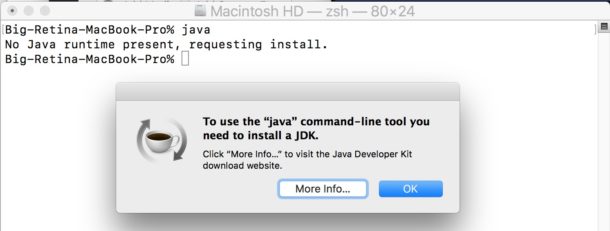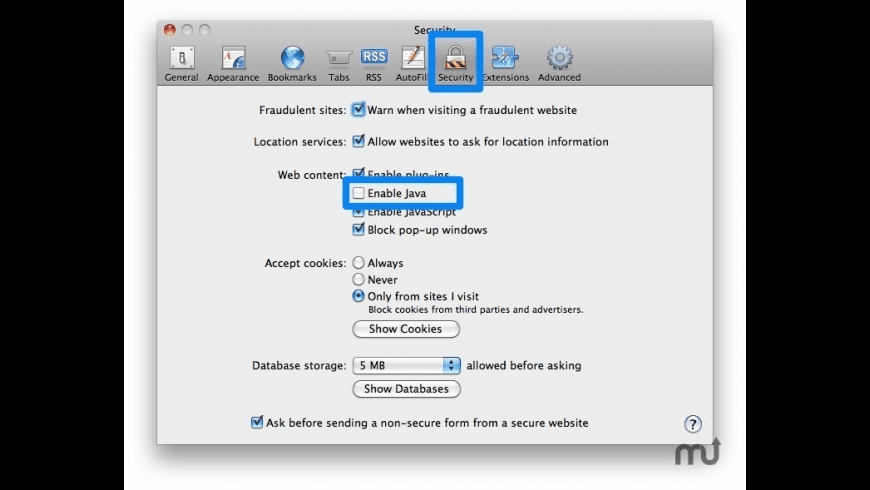- Users must download the new version of the application in order to use it in macOS High Sierra, following the below steps: 1. Deactivate your existing license codes for MMS/MMB: – Open software – Go to Help Licensing Deactivate. Uninstall MMS/MMB from your Mac. Upgrade to macOS High Sierra.
- If you have not yet installed Apple's Java OS X 2012-006 update, then you are still using a version of Apple Java 6 that includes the plug-in and the Java Preferences app. See 'Note for Users of OS X that Include Apple Java 6 Plug-in'. There can be multiple JDKs installed on a system, as many as you wish.
After upgrading to a newer version of Mac OS X (Yosemite 10.10 and El Capitan 10.11) or macOS (Sierra 10.12 and High Sierra 10.13), you may end up getting an annoying new pop-up message whenever you start your computer. It says, “To use the java command-line tool, you need to install a JDK.” It asks you to click “More Info” and visit the JDK (Java Developer Kit) download website.
The reason you’re receiving this message is due to the removal of Java support in newer versions of OS X for security reasons. Older software such as Adobe Photoshop and Illustrator requires legacy Java support. Without a compatible Java command-line tool for these software, you’ll get this pop-up every time you turn on your Mac computer.
When you visit the download website to update Java, you find that the issue isn’t resolved! You’re still getting the same pop-up. This isn’t a complicated issue to fix, but it is an indirect one. The problem is that you’re not being routed to the correct download website when you click “More Info.”
Apple could have remedied this issue by programming the “More Info” button to direct you to the right fix. Here are the steps you can take to finally rid yourself of this pop-up:
Fix Java Command-Line Tool Pop-Up on Mac OS X
Java is one of the most confusing and frustrating add-ons for Mac and here we show you the easiest way to uninstall Java from El Capitan, Sierra and High Sierra. The truth is, there’s actually no way to fully remove Java from Mac but you can easily completely disable it. Java for macOS 2017-001 installs the legacy Java 6 runtime for macOS 10.13 High Sierra, macOS 10.12 Sierra, macOS 10.11 El Capitan, macOS 10.10 Yosemite, macOS 10.9 Mavericks, macOS 10.8 Mountain Lion, and macOS 10.7 Lion.
- Download Java for OS X 2017-001 aka Apple’s version of Legacy Java Command-line tool.
- Mount the .dmg disk image file and install Java 6 runtime for OS X.
- Restart your Mac and enjoy the absence of this Java command-line tool error pop-up!
While working with Ionic and PhoneGap or let’s say anything related to Cordova, I ran into an error requiring Java JDK 1.8 which is required to run the build command. It took a bit of searching to find a concise explanation of how this is done on Mac OSx High Sierra.
The Steps
First find the proper Java Development Kit which is a little confusing because the original error referred to installing JDK 1.8 which which is actually JDK8. Install the following through the standard .dmg method. I found the download here:
http://www.oracle.com/technetwork/java/javase/downloads/jdk8-downloads-2133151.html
Next you want to see which version(s) of Java you have available, you can do this with the following command which returned the two versions listed below for me. By default I was using the 9.0.4 version.
Java Download For Mac Os High Sierra

Once we have these listed, we can use the following to install the version we want to use. Notice the use of the version listed above. Also notice that the statement uses the back tick not a single quote (found with the tilde).
Now we can run the following command to see which Java version is running on our system.
Install Java For Mac
Which should return something like this:
Download Java 8 For Mac High Sierra
Conclusion
Again, it seems pretty straight forward and it is but before some research it was still a little unclear. This will last until you reboot your computer and will revert back to the default Java version. I think this is good practice so that anything using the default version can use it and I can switch the version when I’m in code mode developing apps.
Feel free to ask questions or offer comments below!

